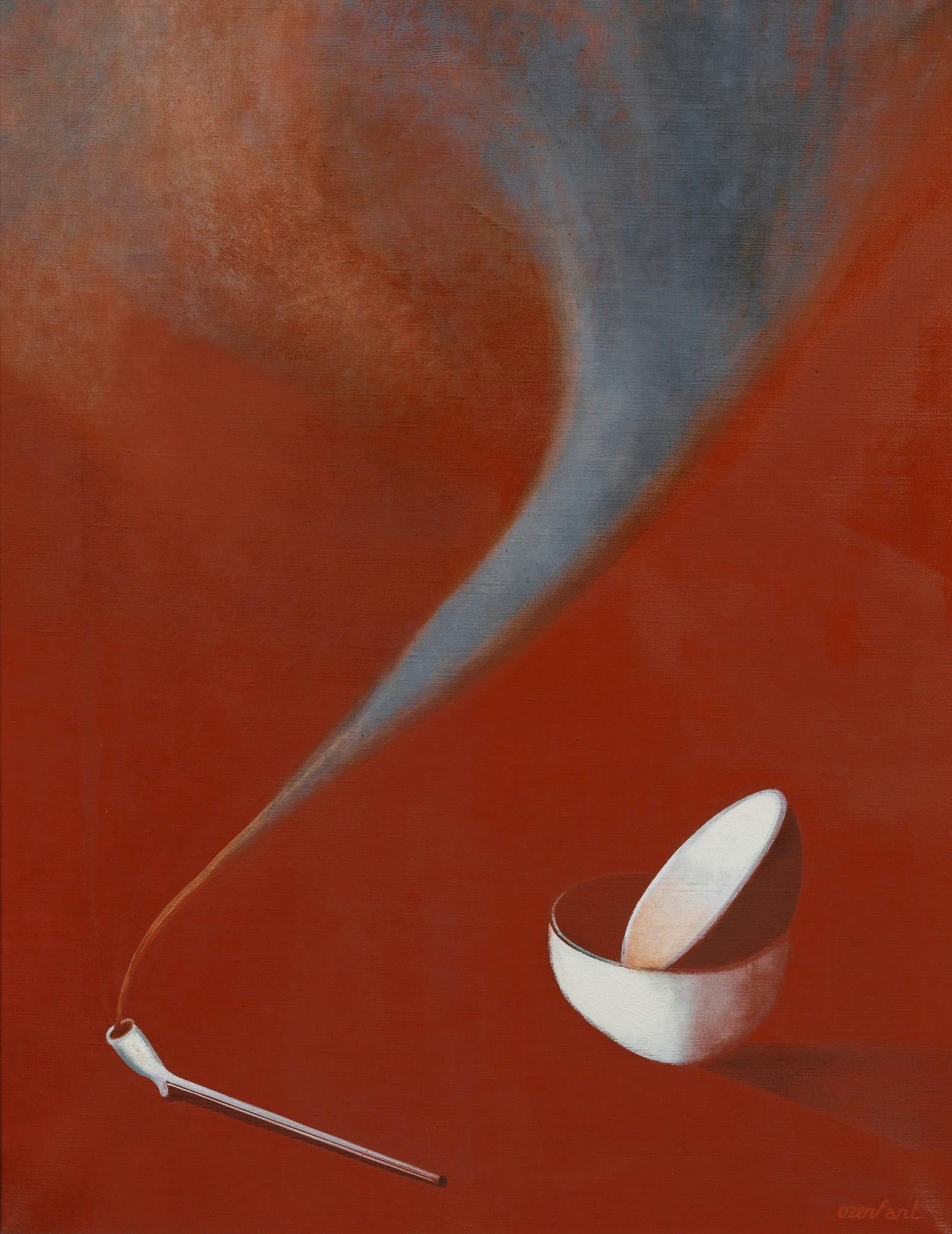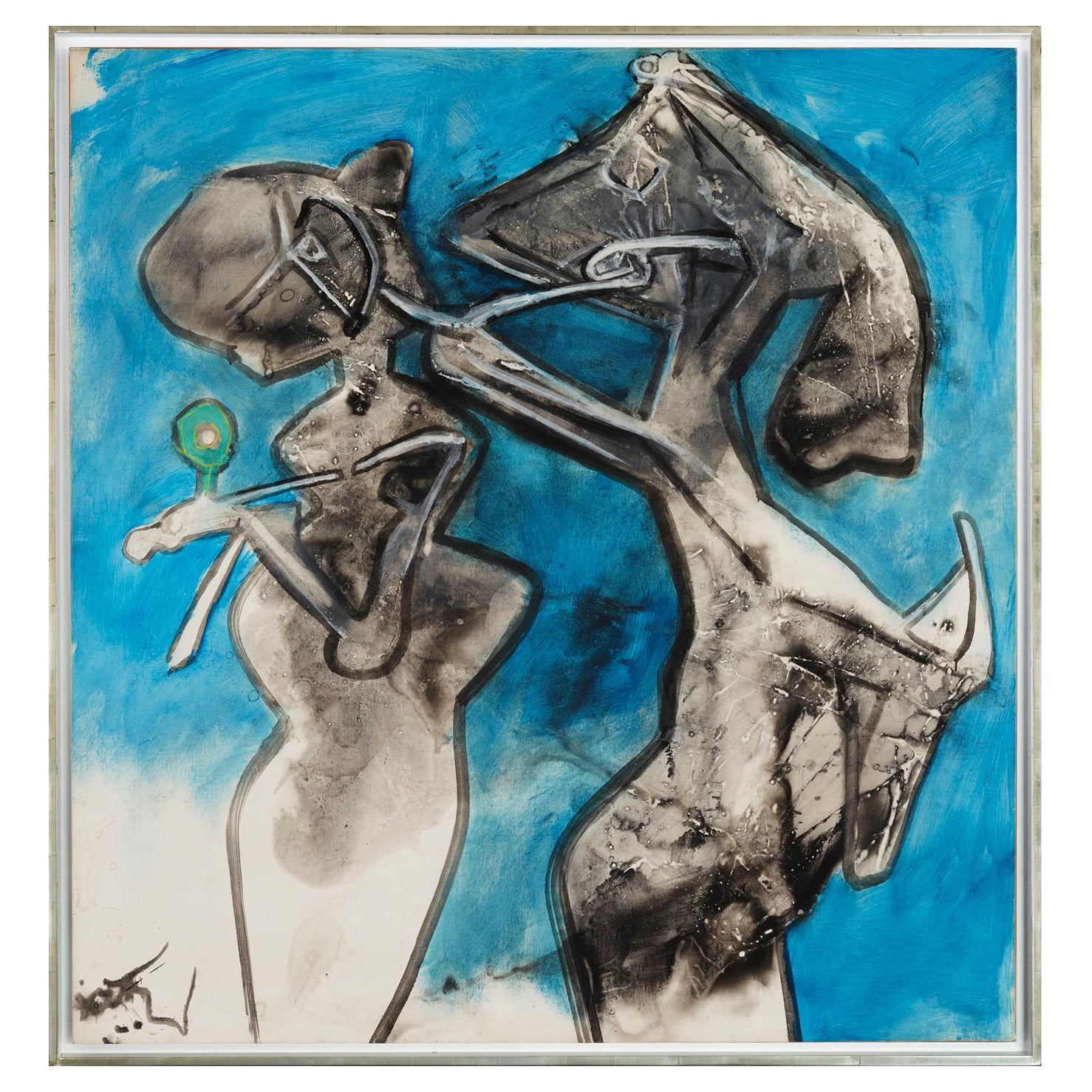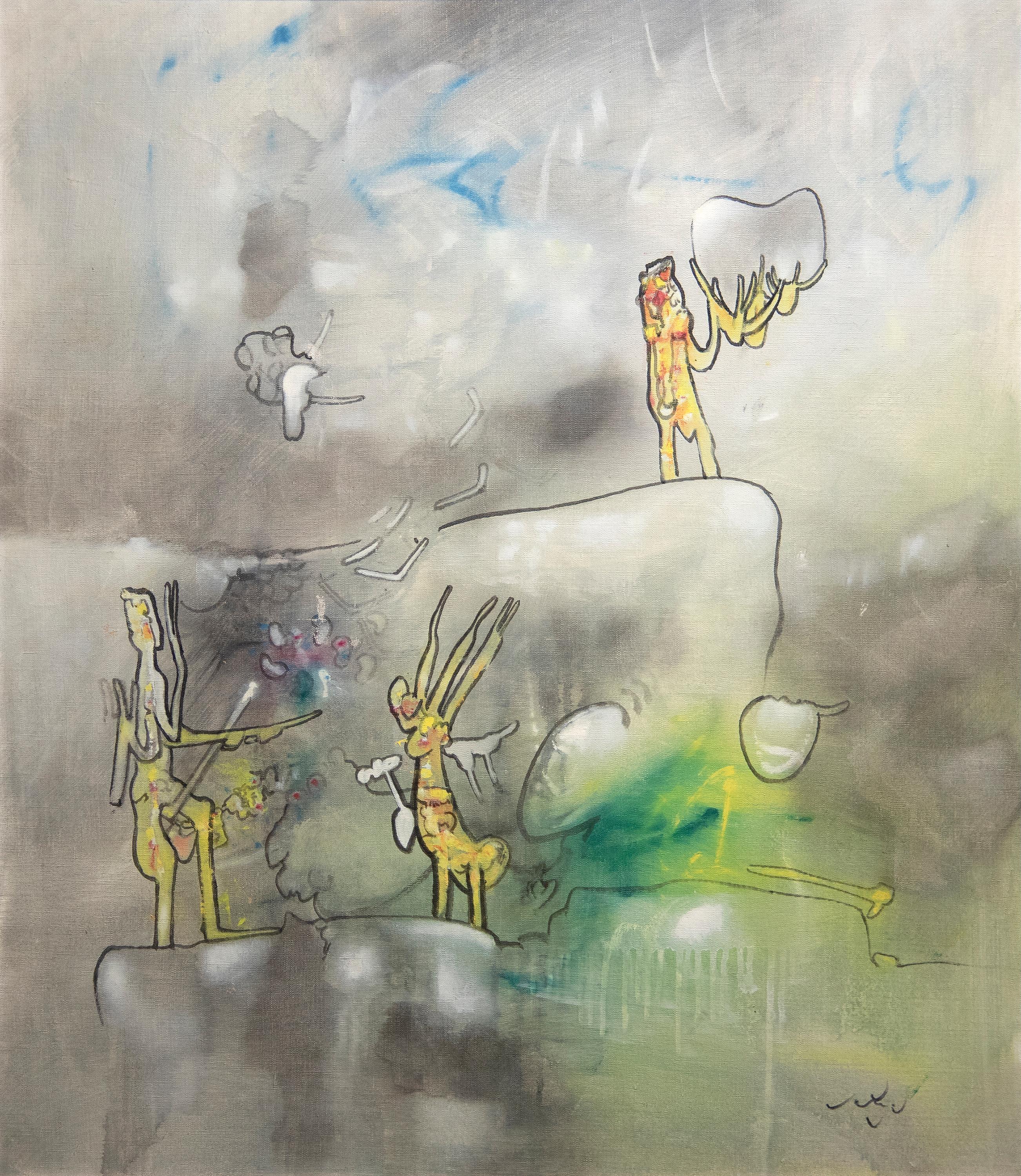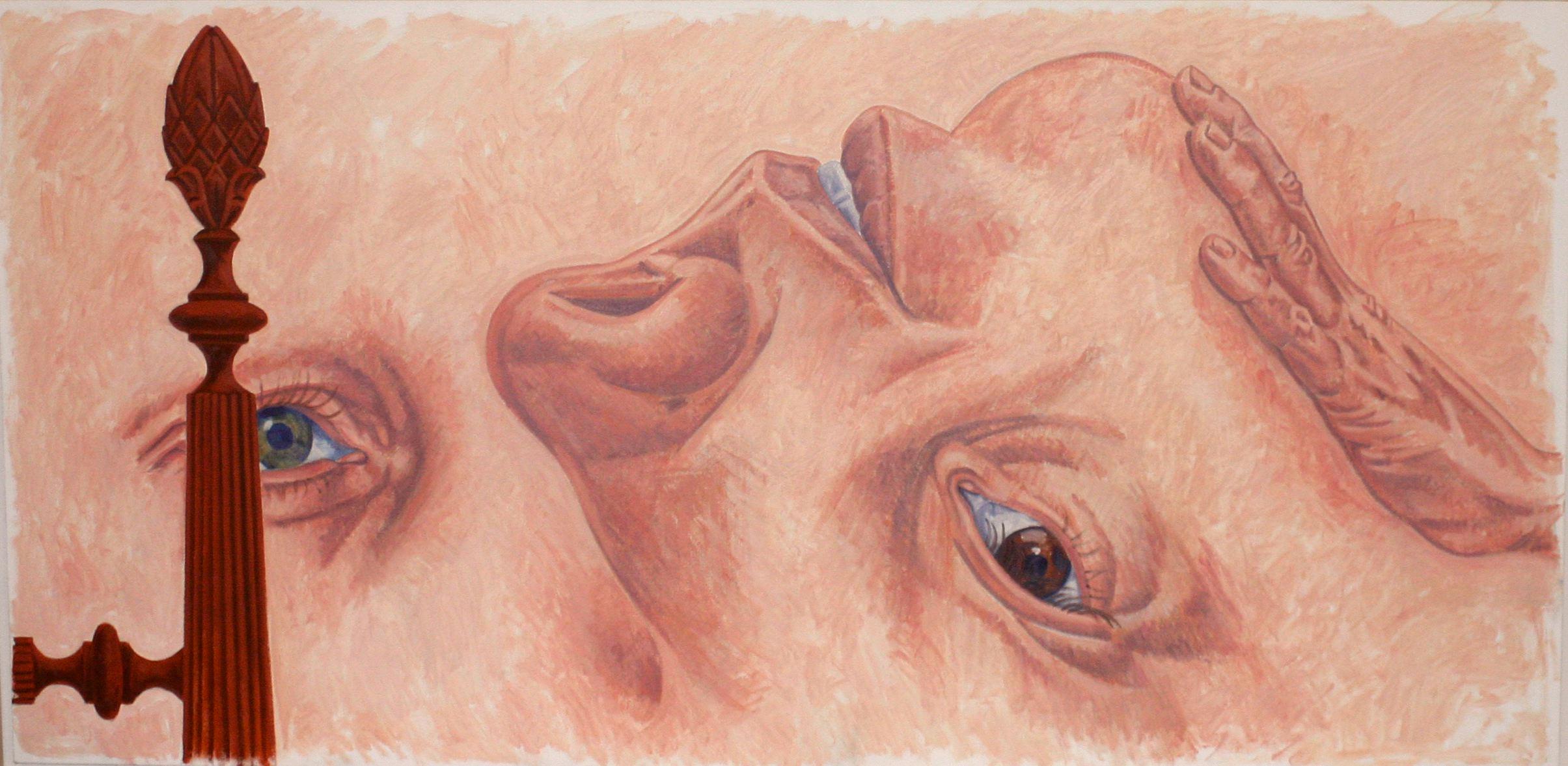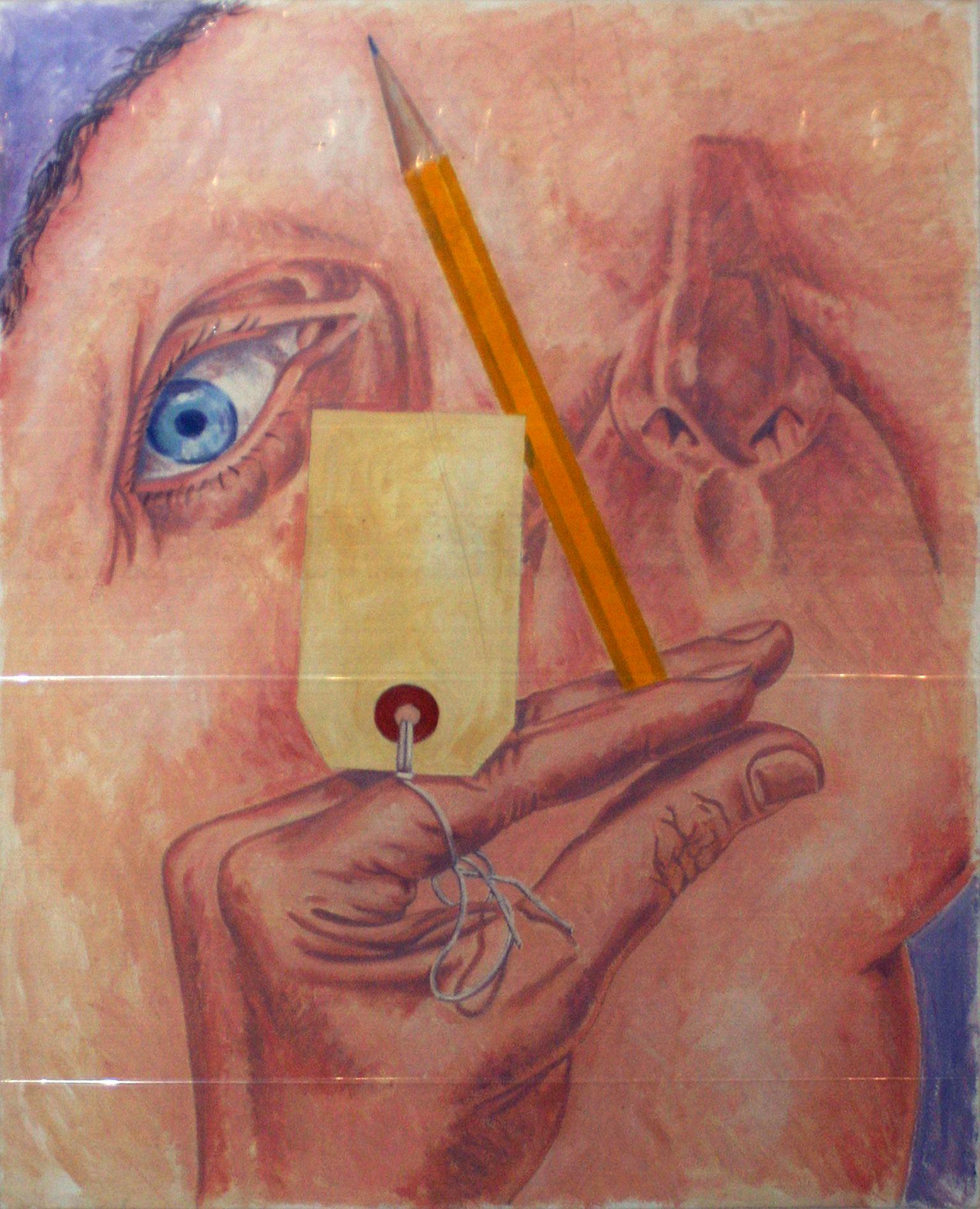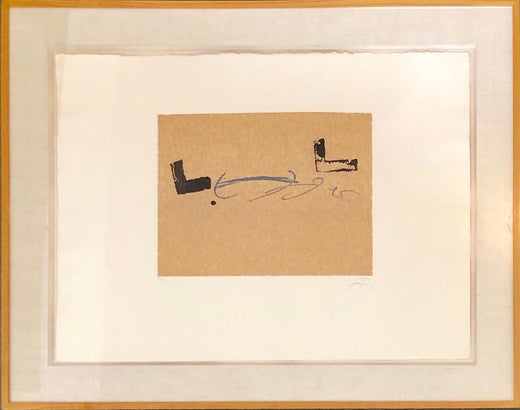Items Similar to Tapies Mid-Century Dau al Set Dada Spain Abstract Surrealism Dark Monster Signed
Want more images or videos?
Request additional images or videos from the seller
Antoni TàpiesTapies Mid-Century Dau al Set Dada Spain Abstract Surrealism Dark Monster Signed1949
1949
About the Item
"Sarpta" is an original oil on canvas painting created by Antoni Tapies. This is a fantastically dark mid-century abstract painting. There is a monstrous figure barely visible on the left side of the painting. Also a sinister face breathing smoke out of the right side of the painting. This piece is perfect for a collector that enjoys a more avantgarde style. Tapies signed, dated, and titled this piece on the backside of the canvas. It is currently in good restored condition. Presented in a new hand-carved, parcel gilt wood frame.
Artwork Size: 25 1/2" x 21 1/4"
Frame Size: 32 1/4" x 28"
Artist Bio:
Antoni Tàpies I Puig, 1st Marquess of Tàpies (Catalan; 13 December 1923-6 February 2012), was a Catalan Spanish painter, sculptor, and art theorist, who became one of the most important artists of the second half of the twentieth century and the best-known Spanish artist to emerge in the period after the Second World War. Largely self-taught, Tàpies first came into contact with art as a teenager through the contemporary art magazine, D’Ací i D’Allà which featured reproductions of works by Duchamp, Baque, Kandinsky, and Picasso. The artist came of age during the Spanish Civil War; his father was a Catalan nationalist and served with the republican government. At 17, he suffered a near-fatal heart attack caused by tuberculosis and spent two years as a convalescent, reading and pursuing his interest in art. He studied law for three years, and in 1943 devoted himself to art. Shortly after becoming an artist, Tàpies attended a clandestine meeting of Els Blaus (the Blues, formed in 1946), an iconoclastic group of Catalan artists and writers. In 1945 he began experimenting with non-painterly materials, mixing paint and whiting. He also became interested in philosophy, particularly Sartre and Eastern thought. In 1948, Tàpies exhibited for the first time in the controversial Salon d’Octubre in Barcelona. It was the first post-War attempt in Spain to introduce the public to new art. The same year, he co-founded, with the poet Jean Brossa, the first post-War movement in Spain known as Dau al Set (the seventh face of the die), which was connected to the Surrealist and Dadaist movements. Under the repression of the Franco regime, Surrealism became a powerful symbol of freedom and transgression for Spanish artists. Tàpies was particularly influenced by Max Ernst, Paul Klee, and Joan Miró, whom he met in 1948 and became a lifelong friend. The artist was interested in magical subjects, and gradually incorporated geometrical elements and color studies in his work.
Sarpta, an oil painting on canvas from 1949 (cat. raisonne, A. Agusti, vol. I, no. 166), is an example of Tàpies’ early, Surrealist work. At the time the work was executed, the artist was a member of the Dau al Set group. The artist’s exploration of Surrealism early in his career was foundational for his ongoing investigation into the nature of physical objects and their materiality. In this painting, the artist emulates Klee and Ernst with his depiction of obscure images surrounded by a dark atmosphere. In Sarpta, a menacing figure emerges from the dark canvas. It rears up on what appear to be human legs, defined with white paint and scratches into the painting’s surface. Its body is amorphous and it has tiny claws. It appears to be bleeding from the chest. It rears its equine head, bearing fang-like teeth and spouting a trail of smoke. Its eyes are scratched into the paint. The figure slips out of the darkness and reveals itself like a surreal pentimenti. On the creature’s back and at the picture’s lower right are partial chessboards. A red sphere appears at the right-hand side of the painting. The upper left appears to be colored smoke. The painting’s surface is scratched throughout and there is a star-like symbol scratched in the upper portion of the work. In Sarpta, Tàpies begins his lifelong interest in matter and explores the theme of transformation expressed through signs and symbols.
Tàpies was championed by the influential French art critic and curator, Michel Tapié. In 1950, Tàpies had his first solo show at Galeries Laietanes in Barcelona. He was also included in the Carnegie International in Pittsburgh. The artist received a French government scholarship in the early 1950s, and lived in Paris for a year, to which he returned frequently. In 1953, he first exhibited in the United States and he also moved away from the painterly styles of Dada and Surrealism and began working in mixed media. He became an informal artist, associated with the European movement known as Art Informel, and worked in a style known as pintura matèrica, in which non-artistic materials are incorporated into paintings. The artist added clay and marble dust to his paint and used waste paper, string and rags. By the mid-1950s, Tàpies had achieved international recognition. His works were shown in major museums and galleries throughout the United States, Europe, Japan, and South America. In the 1960s, the artist incorporated new elements in his works—writing, signs, anthropomorphic elements, footprints, and references to the Catalan situation. He employed new technical methods such as new surfaces, use of everyday objects, and varnish. His work of the early 1970s is marked by symbols of Catalan identity. From around 1970, influenced by Pop Art, Tàpies began incorporating more substantial objects into his paintings such as furniture. Although his work defies clear labels, he has been associated with Tachisme and Abstract Expressionism. The artist emphasized the raw materiality of his works and by bringing together different objects, Tàpies invokes the Surrealist technique of juxtaposition in which objects take on a new order of meaning when taken out their familiar contexts and placed together. He shares a visual vocabulary with contemporaneous Neo-Expressionist artists Francesco Clemente, Julian Schnabel, Cy Tyombly, Anselm Kiefer, and Jean-Michel Basquiat.
Exhibitions of Tàpies’ work include: The Museum of Modern Art, New York; The Guggenheim Museum, New York; The Museum of Contemporary Art, Los Angeles; Serpentine Gallery, London; Hayward Gallery, London; Neue Nationalgalerie, Berlin; Kunsthaus, Zurich Stedelijk Museum, Amsterdam; Haus der Kunst, Munich; Musée d’art Moderne de la Ville de Paris; Jeu de Paume, Paris; Centre Georges Pompidou, Paris; Museo Nacional Centro de Arte Reina Sofia, Madrid; Institut Valencia d’Art Moderna, Valencia; Museu d’Art Contemporani de Barcelona. The artist’s publications: La practica de l’art (1970); L’art contra l’estetica (1974); Memoria personal (1977); La realitat com a art (1982); Per un art modern I progressista (1985); Valor de l’art (1993); L’art I els lloc (1999). In 1984, The artist created the Fundació Tàpies with the aim of promoting the study and knowledge of modern and contemporary art.
- Creator:Antoni Tàpies (1923 - 2012, Spanish)
- Creation Year:1949
- Dimensions:Height: 32.25 in (81.92 cm)Width: 28 in (71.12 cm)
- Medium:
- Movement & Style:
- Period:
- Condition:In good restored condition.
- Gallery Location:Milwaukee, WI
- Reference Number:
Antoni Tàpies
Antoni Tàpies is considered to be Spain's most important painter after Picasso. His work is in the collections of the most important modern and contemporary museums around the world, as well as those of the most notable private collectors. Tàpies’s ultra-typical style was an almost industrial look, expressionistic slashes, thick impasto, rough and impassioned.
About the Seller
4.9
Platinum Seller
These expertly vetted sellers are 1stDibs' most experienced sellers and are rated highest by our customers.
Established in 1966
1stDibs seller since 2017
391 sales on 1stDibs
Typical response time: 1 hour
- ShippingRetrieving quote...Ships From: Milwaukee, WI
- Return PolicyA return for this item may be initiated within 14 days of delivery.
More From This SellerView All
- "Daring Mind Birds on Easy Wings, " Abstract Oil on Canvas by Sue BartfieldBy Sue BartfieldLocated in Milwaukee, WI"Daring Mind Birds on Easy Wings" is an oil on canvas by Sue Bartfield. It is an abstract piece in many shades of blue and pink. 80 1/2" x 67 3/4" art 82" x 69 3/4" frame Sue Bart...Category
1970s Abstract Abstract Paintings
MaterialsCanvas, Oil
- "Erotic Song II, " Abstract Expressionist Oil Painting on Canvas, SignedBy Alayna RoseLocated in Milwaukee, WI"Erotic Song II" is an original oil painting on canvas by Alayna Rose. The artist signed the piece lower right. It features abstract, gestural, and expressionist marks in orange, blue, red, and purple over a black background. 30" x 24" art Custom framing is available Alayna Rose is a painter, jewelry designer and former illustrator. Her fashion jewelry has been featured in exclusive boutiques from Hawaii to the East Coast. In 1987 she was featured as an outstanding new designer in Accessories Magazine. Her copper enameled designs have been exhibited in shows in New York City, Chicago and other major venues in the United States. From 1990-2007 she was Vice President of a design company that specialized in illustrations for patent applications, trademarks and technical art. She studied with Gary Rosine, former department chair of Cardinal Stritch University’s Visual Studies Program, Kenn Kwint, nationally recognized Wisconsin painter and was mentored by one of Wisconsin’s most celebrated sculptors, Mary Nohl...Category
2010s Abstract Expressionist Abstract Paintings
MaterialsCanvas, Oil
- 'Time Augments the Belief, ' Original Oil Painting, SignedBy Daniel KlewerLocated in Milwaukee, WIThis painting is an excellent example of the work of Daniel Klewer, coming from his series 'Botanical Abstractions.' His works in this series follow strict, self-imposed rules: Klewe...Category
2010s Contemporary Abstract Paintings
MaterialsCanvas, Oil
- "Sun Totem, " haitian pattern god sun totem figurative optical signed by artistBy Prospere Pierre LouisLocated in Milwaukee, WI"Sun Totem" is an original acrylic painting on canvas signed and dated lower center by the artist Prospere Pierre Louis. It depicts a few contorted human figures in a totem pole arra...Category
1990s Figurative Paintings
MaterialsCanvas, Oil
- "Song for Lovers, " Symbolic Oil Painting on CanvasBy Xiao MingLocated in Milwaukee, WI"Song For Lovers" is an original oil painting on canvas by Xiao Ming. This artwork features two abstracted figures embracing, a seated figure with a dress, multiple animal heads, and other abstract symbols over a dark blue and black background. 23 3/4" x 19 1/2" art 31 1/2" x 26 1/2" frame Born in the Yunnan province of China, Close to Tibet, Xiao Ming found her artwork on her beliefs and traditions of living with nature as a guardian and protector. These beliefs and traditions may have influenced Ming to favor colored inks, a gouache of sorts derived from mineral pigments bound by using animal glue, Mings work is steeped in Chinese art history, influenced by the ancient scroll...Category
1990s Contemporary Figurative Paintings
MaterialsCanvas, Oil
- "Always Dancing" Abstract Oil on Canvas, SignedBy Alayna RoseLocated in Milwaukee, WI"Always Dancing" is an abstract oil on canvas painting by Alayna Rose. Like the works of abstract expressionist Cy Twombly, Rose uses explosive lines and an extensive palette to capt...Category
Early 2000s Abstract Expressionist Abstract Paintings
MaterialsCanvas, Oil
You May Also Like
- Amédée Ozenfant - Nature morte, Tabagie, french, modern, still life, surrealBy Amédée OzenfantLocated in London, GBsigned ‘ozenfant’ (lower right) Provenance: Sale: Christie's London, 4 April 1989, lot 198 Dr. Arthur Brandt, New York (acquired at the above sale) Literature: P. & M. Guénégan, 'A...Category
1960s Surrealist Still-life Paintings
MaterialsCanvas, Oil
- Les travailleurs de la mèreBy Roberto MattaLocated in Malmo, SEArtwork size: 102,5x98 cm Frame size: 110x105 cm This artwork is accompanied by a certificate of authenticity signed by Alisée Matta. Provenance: Artist Jean-Pierre Jouffroy, Paris. The estate of the artist Jean-Pierre Jouffroy, Paris. “The heart is an eye,” writes Nobel laureate Octavio Paz in an essay on Matta’s paintings. Matta creates a world coloured both by a sunny faith in the future and by visions of impending doom. Roberto Sebastian Echaurren Antonio Matta, who died aged 91 on 23 November 2002, was born in Santiago, Chile, on 11 November 1911 into a family with Spanish, French and Basque roots, and raised in an atmosphere of religiosity. By the age of 21 he had graduated and begun work as an architect, but his leisure time he devoted to sketching and painting. In 1933 he travelled to Europe for the first time, visiting Greece, Yugoslavia, Italy and other countries, and subsequently taking the initiative to collaborate with the architect, Le Corbusier. As time passed, however, Matta’s enthusiasm for a career in architecture waned, and he began to devote himself full-time to art, making early acquaintances with surrealists such as Max Ernst, Salvador Dalí, André Breton and others. Between 1939 and 1948 Matta, like many of his artistic contemporaries, lived in self-imposed exile in the USA, but, after almost 10 years’ absence from Europe, he returned to make first Rome and then, a few years later, Paris his home. Throughout most of the rest of his life Matta commuted between his studio in Paris and his creative refuge in the monastery outside Rome. And it is here, in Italy, that he produced his greatest paintings. Matta’s first retrospective in Sweden was organised in 1956 when his works were exhibited in what was then Galerie Colibri – run by, among others, the artist C O Hultén...Category
1980s Surrealist Paintings
MaterialsCanvas, Oil
- Surrealist Landscape Una Via Romana Antica con Temporale Distante. Italian SceneBy Eugene BermanLocated in Miami, FLSigned "E.B." in a cartouche panel in the upper center, which is repeated on the verso. Includes 19 on the left side and 62 on the right side. h: 33.2 x w: 19.5 in / h: 84.3 x w: 49...Category
1960s Surrealist Landscape Paintings
MaterialsOil, Canvas
- L'epreuveBy Roberto MattaLocated in Palm Desert, CAA painting by Roberto Matta. "L'epreuve" is a surrealist painting, oil on canvas in palette of grays, greens, and yellows by Latin American artist Roberto Matta. It is signed in the ...Category
Mid-20th Century Surrealist Abstract Paintings
MaterialsCanvas, Oil
- UntitledBy Alan TurnerLocated in New York, NYTurner's paintings were classically known for their surrealistic and contorted depictions of the human body.Category
1980s Surrealist Abstract Paintings
MaterialsCanvas, Oil
- Portrait of Klaus KertessBy Alan TurnerLocated in New York, NYTurner's paintings were classically known for their surrealistic and contorted depictions of the human body.Category
1980s Surrealist Abstract Paintings
MaterialsCanvas, Oil
Recently Viewed
View AllMore Ways To Browse
Paris Oil Paintings On Canvas
1949 Paintings
1949 Painting
London Oil On Canvas
Oil On Canvas Paint London
Japanese Canvas Painting
Japanese Painting Canvas
Canvas Painting Japanese
Oil On Canvas Gilt Frame
Oil On Canvas Painting 1950
Painting Label Galleries
Paintings By Miro
Painting To Restore
Painting Oil Paris London
Vintage Canvas Material
Picasso Oil Painting
Twentieth Century Paintings
Early Picasso Painting
